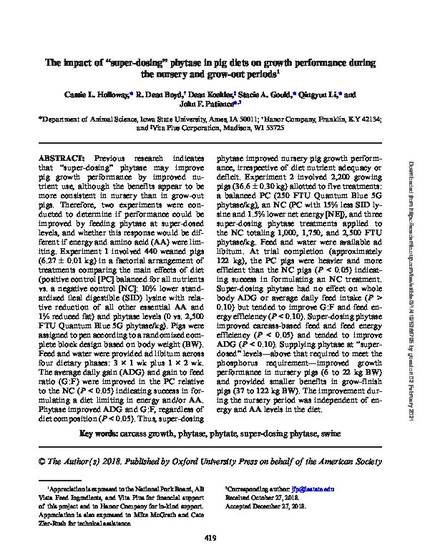
Previous research indicates that “super-dosing” phytase may improve pig growth performance by improved nutrient use, although the benefits appear to be more consistent in nursery than in grow-out pigs. Therefore, two experiments were conducted to determine if performance could be improved by feeding phytase at super-dosed levels, and whether this response would be different if energy and amino acid (AA) were limiting. Experiment 1 involved 440 weaned pigs (6.27 ± 0.01 kg) in a factorial arrangement of treatments comparing the main effects of diet (positive control [PC] balanced for all nutrients vs. a negative control [NC]: 10% lower standardized ileal digestible (SID) lysine with relative reduction of all other essential AA and 1% reduced fat) and phytase levels (0 vs. 2,500 FTU Quantum Blue 5G phytase/kg). Pigs were assigned to pen according to a randomized complete block design based on body weight (BW). Feed and water were provided ad libitum across four dietary phases: 3 × 1 wk plus 1 × 2 wk. The average daily gain (ADG) and gain to feed ratio (G:F) were improved in the PC relative to the NC (P < 0.05) indicating success in formulating a diet limiting in energy and/or AA. Phytase improved ADG and G:F, regardless of diet composition (P < 0.05). Thus, super-dosing phytase improved nursery pig growth performance, irrespective of diet nutrient adequacy or deficit. Experiment 2 involved 2,200 growing pigs (36.6 ± 0.30 kg) allotted to five treatments: a balanced PC (250 FTU Quantum Blue 5G phytase/kg), an NC (PC with 15% less SID lysine and 1.5% lower net energy [NE]), and three super-dosing phytase treatments applied to the NC totaling 1,000, 1,750, and 2,500 FTU phytase/kg. Feed and water were available ad libitum. At trial completion (approximately 122 kg), the PC pigs were heavier and more efficient than the NC pigs (P < 0.05) indicating success in formulating an NC treatment. Super-dosing phytase had no effect on whole body ADG or average daily feed intake (P > 0.10) but tended to improve G:F and feed energy efficiency (P < 0.10). Super-dosing phytase improved carcass-based feed and feed energy efficiency (P < 0.05) and tended to improve ADG (P < 0.10). Supplying phytase at “super-dosed” levels—above that required to meet the phosphorus requirement—improved growth performance in nursery pigs (6 to 22 kg BW) and provided smaller benefits in grow-finish pigs (37 to 122 kg BW). The improvement during the nursery period was independent of energy and AA levels in the diet.
Available at: http://works.bepress.com/john-patience/91/

This article is published as Holloway, Cassie L., R. Dean Boyd, Dean Koehler, Stacie A. Gould, Qingyun Li, and John F. Patience. "The impact of “super-dosing” phytase in pig diets on growth performance during the nursery and grow-out periods." Translational Animal Science 3, no. 1 (2019): 419-428. doi:10.1093/tas/txy148.